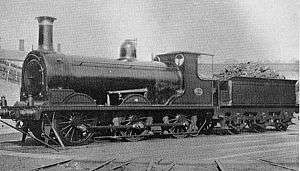LB&SCR C1 class
LB&SCR C1 class|

C1 class No.422 c. 1890 |
|
|
| Specifications |
|---|
| Configuration |
0-6-0 |
|---|
| UIC class |
Cn |
|---|
| Gauge |
4 ft 8 1⁄2 in (1,435 mm) standard gauge |
|---|
| Driver dia. |
60 in (1.524 m) |
|---|
| Wheelbase |
15 ft 3 in (4.65 m) |
|---|
| Length |
48 ft 7 in (14.81 m) |
|---|
| Loco weight |
40.35 long tons (41.00 t; 45.19 short tons) |
|---|
| Fuel type |
Coal |
|---|
| Fuel capacity |
6.5 long tons (6.6 t; 7.3 short tons) |
|---|
| Water cap |
2,520 imp gal (11,500 l; 3,030 US gal) |
|---|
Firebox:
• Firegrate area |
20.9 sq ft (1.94 m2) |
|---|
| Boiler pressure |
150 psi (10.34 bar; 1.03 MPa) |
|---|
Heating surface:
• Tubes |
1,312 sq ft (121.9 m2) |
|---|
| • Firebox |
101 sq ft (9.4 m2) |
|---|
| Cylinders |
Two, inside |
|---|
| Cylinder size |
18 1⁄4 in × 26 in (464 mm × 660 mm) |
|---|
|
|
|
| Career |
|---|
| Operators |
LB&SCR |
|---|
| Class |
C1 |
|---|
| Withdrawn |
1907–1924 |
|---|
| Disposition |
All Scrapped |
|---|
|
The London, Brighton and South Coast Railway (LB&SCR) C1 class was a type of 0-6-0 freight steam locomotive designed by William Stroudley.
Construction and use
The twelve locomotives in the class were built by Brighton Works between 1882 and 1887, based upon Stroudley's disappointing C class 0-6-0 design of 1873–74, but incorporating a larger boiler. However, the new locomotives were not as successful as Stroudley's designs for passenger locomotives and no further examples were built. Their comparatively short lives were spent hauling freight trains on the LB&SCR. Most of the members of the class were withdrawn between 1907 and 1911, but two examples survived until 1920 and 1924 respectively. One locomotive (number 428) was sold to the Stratford-on-Avon & Midland Junction Railway, and survived until June 1925. [1]
Locomotive Summary
C1 class fleet summary
| Original Number | Built | 2nd No. | Renumber date | Withdrawn |
|---|
| 421 |
000000001882-08-01-0000August 1882 |
691 |
000000001910-12-01-0000December 1910 |
000000001911-01-01-0000January 1911 |
| 422 |
000000001882-09-01-0000September 1882 |
692 |
000000001910-12-01-0000December 1910 |
000000001911-01-01-0000January 1911 |
| 423 | 000000001882-09-01-0000September 1882 | — | — | 000000001908-11-01-0000November 1908 |
| 424 | 000000001882-10-01-0000October 1882 | — | — | 000000001908-11-01-0000November 1908 |
| 425 | 000000001882-11-01-0000November 1882 | — | — | 000000001907-08-01-0000August 1907 |
| 426 | 000000001882-12-01-0000December 1882 | — | — | 000000001907-09-01-0000September 1907 |
| 427 | 000000001884-05-01-0000May 1884 | — | — | 000000001911-03-01-0000March 1911 |
| 428 | 000000001884-06-01-0000June 1884 | — | — | 000000001920-11-01-0000November 1920 |
| 429 | 000000001884-06-01-0000June 1884 | — | — | 000000001907-08-01-0000August 1907 |
| 430 | 000000001887-07-01-0000July 1887 | — | — | 000000001924-09-01-0000September 1924 |
| 431 | 000000001887-07-01-0000July 1887 | — | — | 000000001907-08-01-0000August 1907 |
| 432 | 000000001887-07-01-0000July 1887 | — | — | 000000001910-12-01-0000December 1910 |
|
References
- ↑ Locomotives Illustrated issue 159, page 44
- Bradley, D.L. (1969). Locomotives of the London Brighton and South Coast Railway: Part 1. Railway Correspondence and Travel Society.
- Haresnape, Brian (1985). Stroudley Locomotives, a pictorial history. Shepperton, Surrey: Ian Allan Limited. ISBN 0-7110-1391-8.
